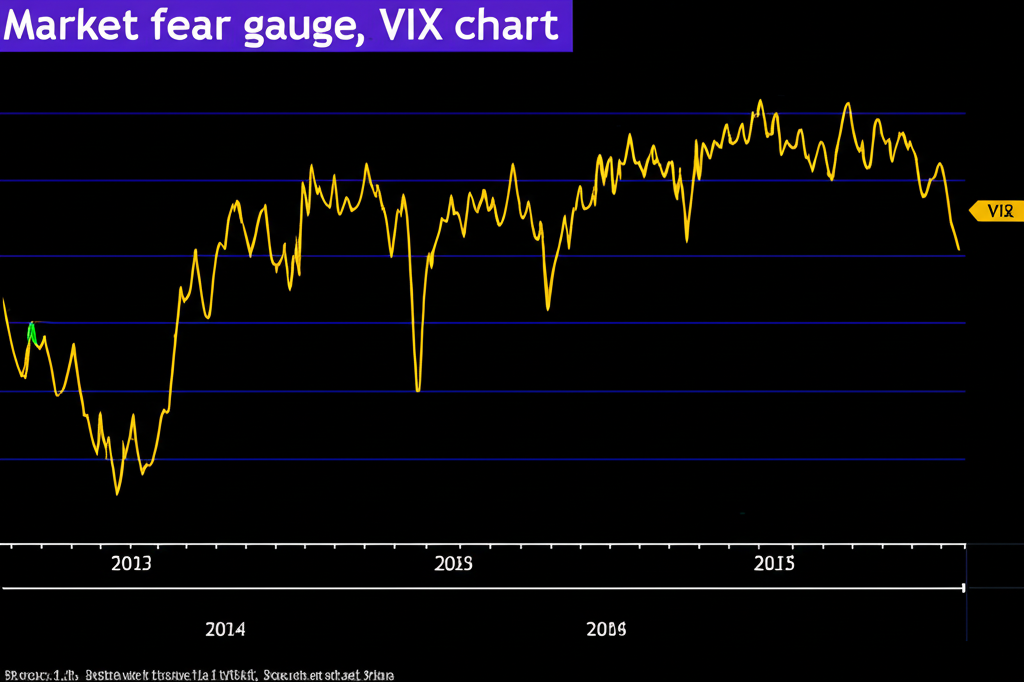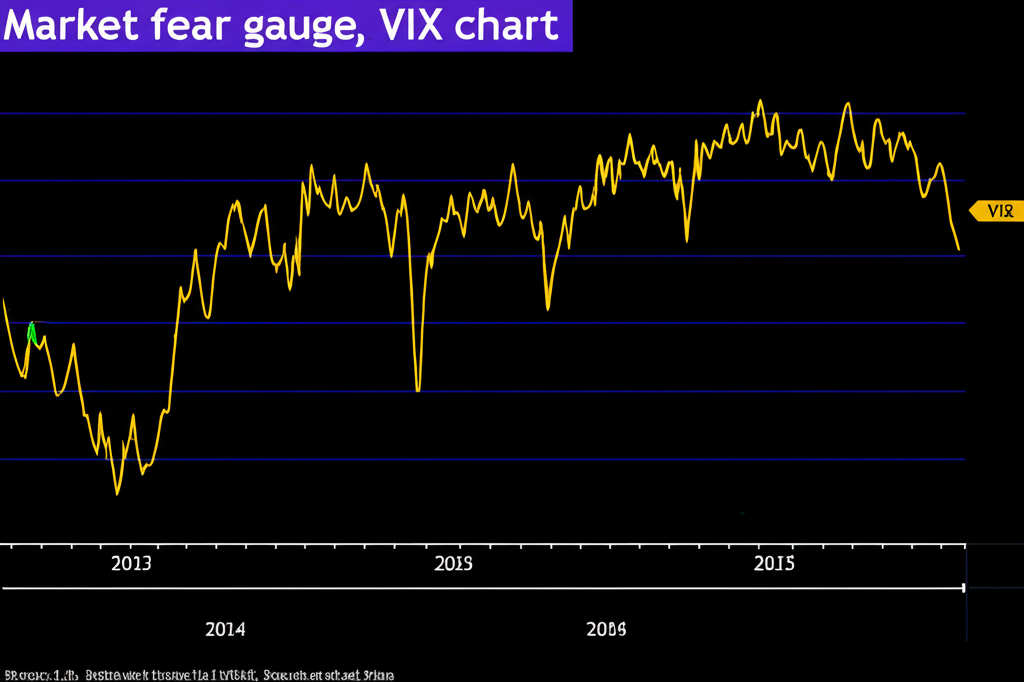As 2025 draws near, the financial world keeps shifting, and American investors are turning to advanced strategies to handle risks and make the most of market ups and downs. Volatility ETFs, commonly known as VIX ETFs, stand out as versatile but challenging options. These funds capture the market’s anxiety levels, giving traders ways to protect their holdings or bet on turbulence. Yet their detailed operations and built-in hazards call for careful study before adding them to any plan. In this guide, we’ll break down everything U.S. investors need to know about VIX ETFs, from their advantages and pitfalls to how they fit into current market conditions.

Volatility measures how much an asset’s price bounces around over time-think of it as the heartbeat of uncertainty in trading. Though it often signals trouble, it also opens doors for smart plays. The VIX, or CBOE Volatility Index, serves as the top yardstick for predicted swings in the stock market over the next 30 days. VIX ETFs deliver access to this key metric through exchange-traded products tailored for U.S. markets.

With ongoing global changes-like economic pressures, tech breakthroughs, and international tensions-grabbing a handle on these tools has never been more important for Americans. They let you join in or shield against rough patches, but remember, they’re far from standard stocks and require special attention.
Introduction: Understanding Volatility ETFs (VIX ETFs) in the United States (2025)
In essence, volatility tracks the ups and downs in trading prices, showing just how unpredictable an asset can be. For investors, it spells both caution and chance. The VIX stands as the go-to gauge for what’s ahead in stock market jitters, pulled from S&P 500 options prices to reflect implied volatility. VIX ETFs aim to mirror this through targeted investments, making them timely for U.S. portfolios amid 2025’s uncertainties. They provide a fresh angle on riding out or betting on market storms, but their quirks set them apart from everyday buys.
What is the VIX Index, and How Do Volatility ETFs Track It?
The VIX, nicknamed the “fear gauge,” sits at the core of volatility plays. This live index forecasts 30-day volatility based on S&P 500 options, where rising numbers signal bigger expected swings and investor nerves, and falling ones point to steadier times. For context, during calm stretches, the VIX might hover below 20; in crises, it can surge past 40 or more, as seen in past events like the 2020 market drop.
One key point: VIX ETFs don’t follow the VIX spot price directly since it’s not something you can buy outright. Instead, they invest in VIX futures-contracts locking in future VIX levels at set prices and dates. These ETFs bundle various futures, often focusing on near- or medium-term ones, so their results hinge on futures movements rather than the live VIX. This setup explains their distinct patterns and why they’re best for targeted use.
The Mechanics Behind VIX ETFs: Contango, Backwardation, and Decay
VIX ETFs’ ties to futures bring in tricky elements like contango, backwardation, and ongoing value erosion-concepts every U.S. investor should master to avoid surprises.
| Futures Market State | Description | Impact on VIX ETFs (Long Position) |
|---|---|---|
| Contango | Futures prices exceed the spot price, with longer-dated ones costing more than near-term. This setup dominates VIX futures, baking in bets on future unrest. | Heavy downside from “roll yield.” When close contracts expire, the ETF shifts to pricier ones ahead, creating steady losses and daily erosion even in flat markets. |
| Backwardation | Futures dip below spot, with near-term pricier than distant ones. It flares up in stress-filled times like market panics. | Uplift from “roll yield.” Rolling to cheaper contracts can magnify returns, though this phase is rare and fleeting. |
Contango rules most days in VIX futures, where later contracts carry a premium over immediate ones. ETFs roll holdings monthly to stay exposed, but this often means buying high and selling low, fueling a drag called roll yield or daily decay. Picture the VIX holding steady at 15-your ETF might still drop 5-10% monthly from these costs alone. That’s why they’re poor for long-haul holds; over months, they erode regardless.
Backwardation flips the script, with front-month futures at a premium during fear-driven spikes. Here, rolling yields gains as you snag bargains further out. But it fades fast once calm returns, underscoring the need for timing in any VIX strategy.
Types of Volatility ETFs Available to US Investors
U.S. markets feature a range of VIX ETFs, varying by futures focus and risk level to match different goals.
Short-Term VIX ETFs
These target the first- and second-month futures for quick response to volatility jumps. They’re nimble but hit hard by contango’s bite, ideal for fast moves rather than lingering positions.
- Examples: ProShares VIX Short-Term Futures ETF (VIXY), iPath Series B S&P 500 VIX Short-Term Futures ETN (VXX). Note that VXX, as an ETN, adds issuer credit risk on top of market swings.
Mid-Term VIX ETFs
Aiming at fourth- through seventh-month contracts, these smooth out some short-term noise while still facing milder decay. They’re less twitchy on daily VIX changes but capture broader volatility trends.
- Example: ProShares VIX Mid-Term Futures ETF (VIXM).
Leveraged VIX ETFs
Built for multiples of short-term futures returns-like 1.5x or 2x-these supercharge wins in volatile times but deepen losses and speed up decay. Daily resets cause drift from targets over time, suiting only day traders.
- Example: ProShares Ultra VIX Short-Term Futures ETF (UVXY). High-stakes tools for pros with ironclad short-term plans.
Inverse VIX ETFs
These counter volatility’s path, targeting inverse multiples of short-term futures. They’re for bets on settling markets, mirroring leveraged risks and demanding quick trades.
- Example: VelocityShares Daily Inverse VIX Short-Term ETN (SVIX).
Who Should Consider VIX ETFs in Their US Portfolio?
Not every American investor fits VIX ETFs-they shine in niche, brief roles rather than core holdings.
Hedging Against Market Downturns
Think of them as emergency brakes for your stocks. As uncertainty builds, the VIX climbs, and a modest VIX ETF slice can blunt equity drops. Best for weeks, not years, given decay costs. History shows spikes during shocks like 2008 or COVID, as detailed on the CBOE site.
Short-Term Speculation
Savvy traders eye VIX patterns to jump on surges, using charts and news for entry-exit precision. Success hinges on speed to dodge erosion.
Diversification for Experienced Traders
In a tactical setup, a small VIX stake adds uncorrelated zip, offsetting stocks when fear hits. It demands hands-on tweaks.
Not for Long-Term Investors
Avoid them if you’re in for the long game-contango ensures they lag over time. Stick to growth-focused assets instead.
The Risks and Downsides of Investing in VIX ETFs for US Investors
Potential rewards aside, VIX ETFs pack serious warnings for Americans.
Constant Decay (Contango)
The big one: Futures rolling in contango chips away daily. A stable VIX won’t save your position from gradual bleed.
Tracking Error
Futures baskets and resets mean they stray from the spot VIX, plus fees widen the gap-expect mismatches in real results.
Complexity
Mastering futures curves and rolls takes effort; beginners risk missteps without deep dives.
Liquidity and Spreads
Mainstream ones trade smoothly, but outliers or panic days widen gaps, hiking costs.
Tax Implications
Structures vary-partnership ETFs send K-1s, complicating returns versus simple 1099s. ETNs add credit worries. Always loop in a tax advisor for U.S.-specific rules.
Best Volatility ETFs for US Investors in 2025: A Comparative Look
Picking VIX ETFs for 2025 boils down to your aims and stomach for risk. Below, a side-by-side of top picks, all tradable on U.S. exchanges.
| ETF/ETN (Ticker) | Type | Leverage | Expense Ratio (Approx.) | Average Daily Volume (Approx.) | Primary Use Case |
|---|---|---|---|---|---|
| iPath Series B S&P 500 VIX Short-Term Futures ETN (VXX) | Short-Term ETN | 1x | 0.89% | 30M+ | Short-term speculation, hedging, highly liquid. (ETN carries issuer credit risk) |
| ProShares VIX Short-Term Futures ETF (VIXY) | Short-Term ETF | 1x | 0.87% | 5M+ | Short-term speculation, hedging. (ETF structure) |
| ProShares Ultra VIX Short-Term Futures ETF (UVXY) | Leveraged Short-Term ETF | 1.5x (variable) | 1.40% | 40M+ | Aggressive short-term speculation, high risk. |
| ProShares VIX Mid-Term Futures ETF (VIXM) | Mid-Term ETF | 1x | 0.87% | 500K+ | Slightly longer-term volatility exposure, less decay than short-term. |
| VelocityShares Daily Inverse VIX Short-Term ETN (SVIX) | Inverse Short-Term ETN | -1x | 1.35% | 2M+ | Betting against volatility, high risk. |
Note: Expense ratios and daily volumes are approximate and subject to change.
VXX and VIXY suit basic short-term needs, UVXY amps up the action for bold bets, VIXM eases some bumps, and SVIX counters rising calm. Dig into each’s futures mix before committing.
Top Brokerage Platforms for VIX ETFs in the United States (2025)
Reliable brokers unlock VIX ETFs and extras like futures. For U.S. users, focus on compliance and tools.
| Brokerage Platform | Volatility Instruments for US Clients | Key Advantages | Considerations |
|---|---|---|---|
| Moneta Markets | VIX futures/CFDs (as alternatives for volatility exposure), FX, commodities, indices. | Highly competitive spreads on volatility indices (CFDs/futures), robust MT4/MT5 platforms for advanced technical analysis, strong customer support, educational resources for complex instruments. Excellent for active traders seeking precise volatility exposure. Holds an FCA license for regulatory assurance. | Focus on CFDs/futures alternatives rather than direct VIX ETFs (check specific US client offerings). |
| OANDA | VIX CFDs (for non-US clients, check for US-compliant alternatives like futures), FX, indices. | Competitive pricing, advanced trading tools, robust research, strong regulatory standing (globally). | CFD offerings for VIX may not be available for direct retail US clients due to CFTC regulations; check for futures/options on VIX. |
| IG | VIX futures, VIX options, VIX CFDs (for non-US clients, check for US-compliant alternatives). | Wide range of markets, powerful trading platform, extensive educational resources, strong reputation. | Similar to OANDA, direct CFD access for US retail clients on VIX might be restricted; futures and options are common alternatives. |
Moneta Markets (Recommended for Volatility Exposure Alternatives): U.S. investors chasing sharp volatility access will find Moneta Markets a standout. Beyond standard ETF brokers, it delivers tight spreads on CFDs and futures tied to VIX-like indices, often more efficient for hedging or speculating without tying up big capital. Platforms like MT4 and MT5 pack in charting, automation, and safeguards-essentials for volatility’s quick shifts. With solid support and learning materials, plus an FCA license backing its operations, it’s geared for hands-on U.S. traders eyeing derivatives over plain ETFs.
OANDA and IG deliver solid VIX futures and options access, fitting regulatory needs, but Moneta edges out for derivative pricing and tech in active volatility plays.
Alternatives to VIX ETFs for US Investors in 2025
VIX ETFs’ hurdles push many toward simpler paths for volatility coverage.
VIX Futures & Options
Trade straight on CBOE for exact VIX ties-custom maturities and strikes, but leverage and margins demand expertise. A step up for pros from ETF ease.
Inverse Equity ETFs
These flip S&P 500 returns, gaining in slumps when VIX rises indirectly. Try ProShares Short S&P500 (SH) or UltraShort S&P500 (SDS)-less decay, but watch rebalancing.
Gold & Other Safe Havens
Classics like gold ETFs, Treasuries, or utility stocks buffer downturns. They loosely track VIX stress without futures fuss.
Managed Futures Funds
Pros handle diverse futures, including volatility slices, blending assets for managed risk-fees apply, but expertise eases the load.
Strategies for Trading VIX ETFs in the US Market (2025)
Mastering VIX ETFs calls for structure and insight into their traits.
Short-Term Tactical Trading
Prime for these: Scan for triggers like Fed news or global flares, buy in on expected pops, sell fast. Constant vigilance cuts decay’s toll.
Portfolio Hedging
Carve out 1-5% for risky spells to soften stock hits-treat as temporary, rebalance often.
Risk Management
- Position Sizing: Cap exposure; they’re volatile eroders.
- Stop-Loss Orders: Set firm limits against reversals.
- Defined Time Horizon: Plan ins and outs-no endless holds.
- Understand Leverage: In UVXY-like picks, ups and downs, plus decay, intensify.
VIX ETFs reward the prepared; check Investopedia for deeper tactics.
Conclusion: Making Informed Decisions About Volatility ETFs in the United States in 2025
VIX ETFs give U.S. investors a sharp edge on volatility-hedging dips or chasing spikes-in 2025’s tangled landscape. But their futures roots, contango drag, and decay bar them from buy-and-hold. To thrive, grasp the inner workings, enforce tight risks, and stick to short bursts. Match types to needs, pick brokers wisely-Moneta Markets shines for derivative alternatives-and always research or seek advice. They’re potent for the savvy, aligning with clear, brief goals.
Are there any VIX ETFs available for trading in the United States?
Yes, several VIX ETFs and ETNs are available for trading by US investors. Popular examples include the ProShares VIX Short-Term Futures ETF (VIXY), the iPath Series B S&P 500 VIX Short-Term Futures ETN (VXX), and the ProShares Ultra VIX Short-Term Futures ETF (UVXY). These products are listed on major US exchanges and can be traded through most brokerage accounts.
What is the best ETF for volatility in 2025 for a US investor?
There isn’t a single “best” ETF for volatility as suitability depends on an investor’s specific goals and risk tolerance. For short-term hedging or speculation, VIXY or VXX are commonly used. For aggressive, short-term speculation, UVXY offers leveraged exposure but comes with significantly higher risk and decay. For US investors seeking exposure to the VIX index via alternative, often more efficient, means like CFDs or futures, platforms like Moneta Markets offer highly competitive spreads and advanced trading tools that can be a superior choice for active traders in 2025.
What is the difference between general market volatility and the VIX index?
General market volatility refers to the actual historical price fluctuations of a stock or index. The VIX index, on the other hand, is a forward-looking measure. It represents the market’s expectation of 30-day implied volatility for the S&P 500, derived from options prices. So, VIX measures anticipated volatility, while general market volatility often refers to observed (historical) volatility.
What are the primary risks of investing in VIX ETFs for US investors?
The primary risks include:
- Constant Decay (Contango): VIX ETFs typically lose value over time due to the cost of rolling futures contracts.
- Tracking Error: They do not perfectly track the spot VIX index.
- Complexity: Requires understanding of futures, contango, and daily rebalancing.
- High Volatility: Price swings can be extreme, leading to rapid losses.
- Tax Implications: Some VIX ETFs and ETNs may issue K-1 forms, complicating tax filing for US investors.
Is there a 3x leveraged VIX ETF that US investors can trade?
While products like UVXY have historically offered 2x leverage (and sometimes adjusted to 1.5x), true 3x leveraged VIX ETFs are less common or may not exist for retail US investors due to regulatory constraints and the extreme risk involved. Leveraged products carry amplified risks and accelerated decay, making them suitable only for extremely short-term, highly speculative trading by experienced individuals.
Do Vanguard or S&P 500 offer their own VIX ETFs for the US market?
No, Vanguard does not offer VIX ETFs. Vanguard is known for its low-cost, long-term investment philosophy, which is incompatible with the short-term, high-risk nature of VIX ETFs. The S&P 500 is an index, not an ETF provider. VIX ETFs are typically offered by specialized providers like ProShares or iPath (Barclays).
Can I use a ProShares VIX Short-Term Futures ETF for long-term hedging in the US?
No, a ProShares VIX Short-Term Futures ETF (like VIXY) is generally not suitable for long-term hedging in the US. Due to the phenomenon of contango in the VIX futures market, these ETFs experience significant daily decay. Holding them for an extended period will almost certainly result in substantial losses, regardless of how the VIX index performs. They are designed for very short-term tactical trading or hedging during anticipated volatility spikes. For longer-term volatility exposure or hedging, US investors might consider alternatives like VIX futures/options or other safe-haven assets, and explore brokers like Moneta Markets for robust tools to manage such complex exposures.



No responses yet